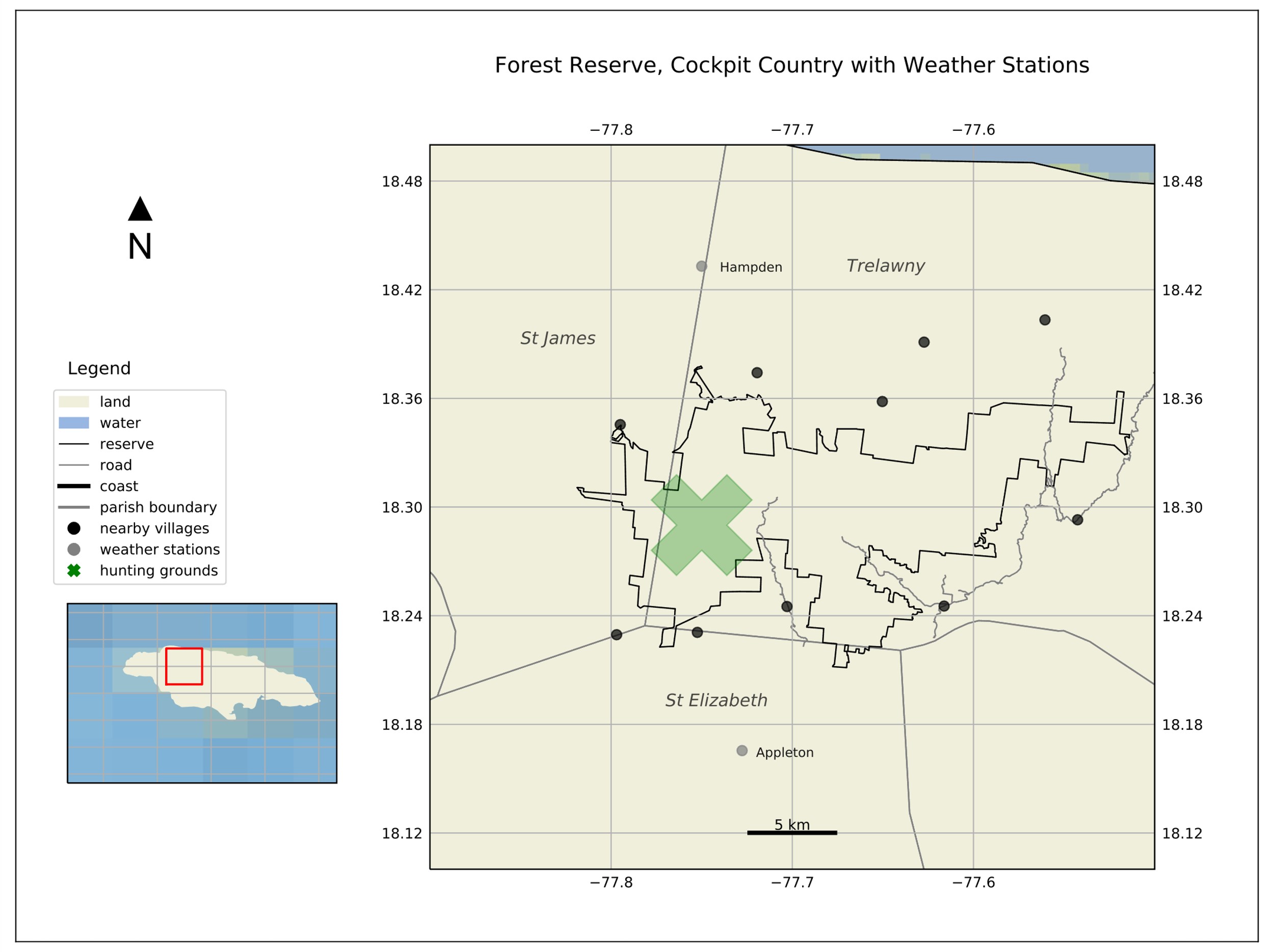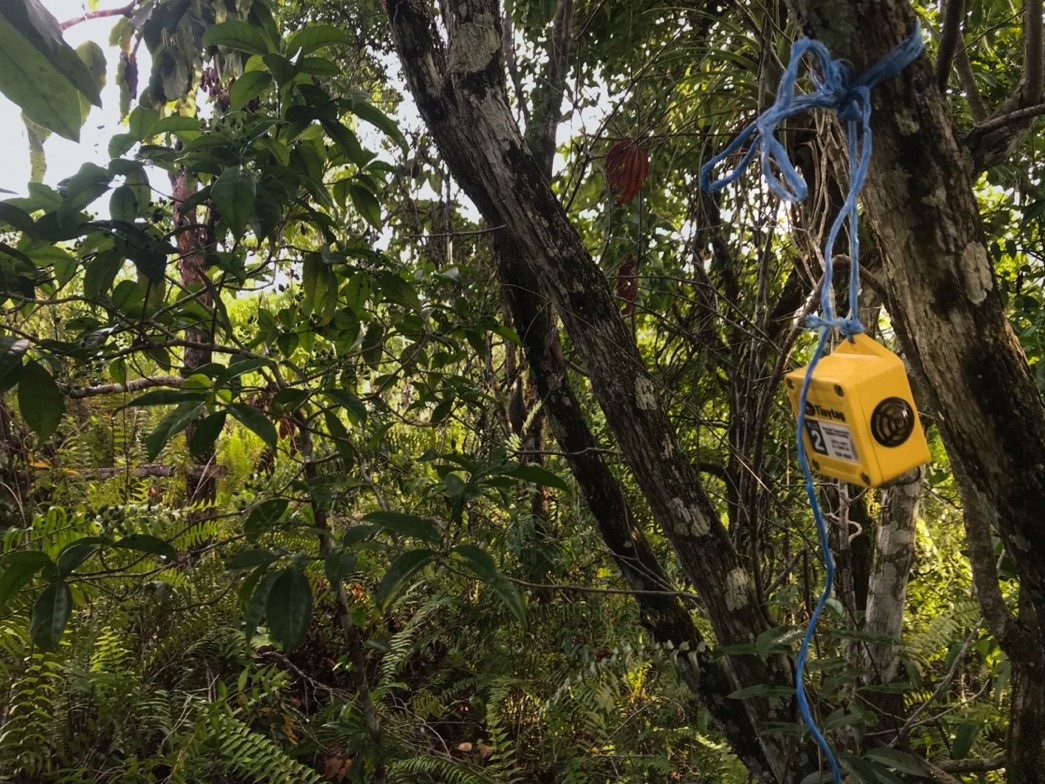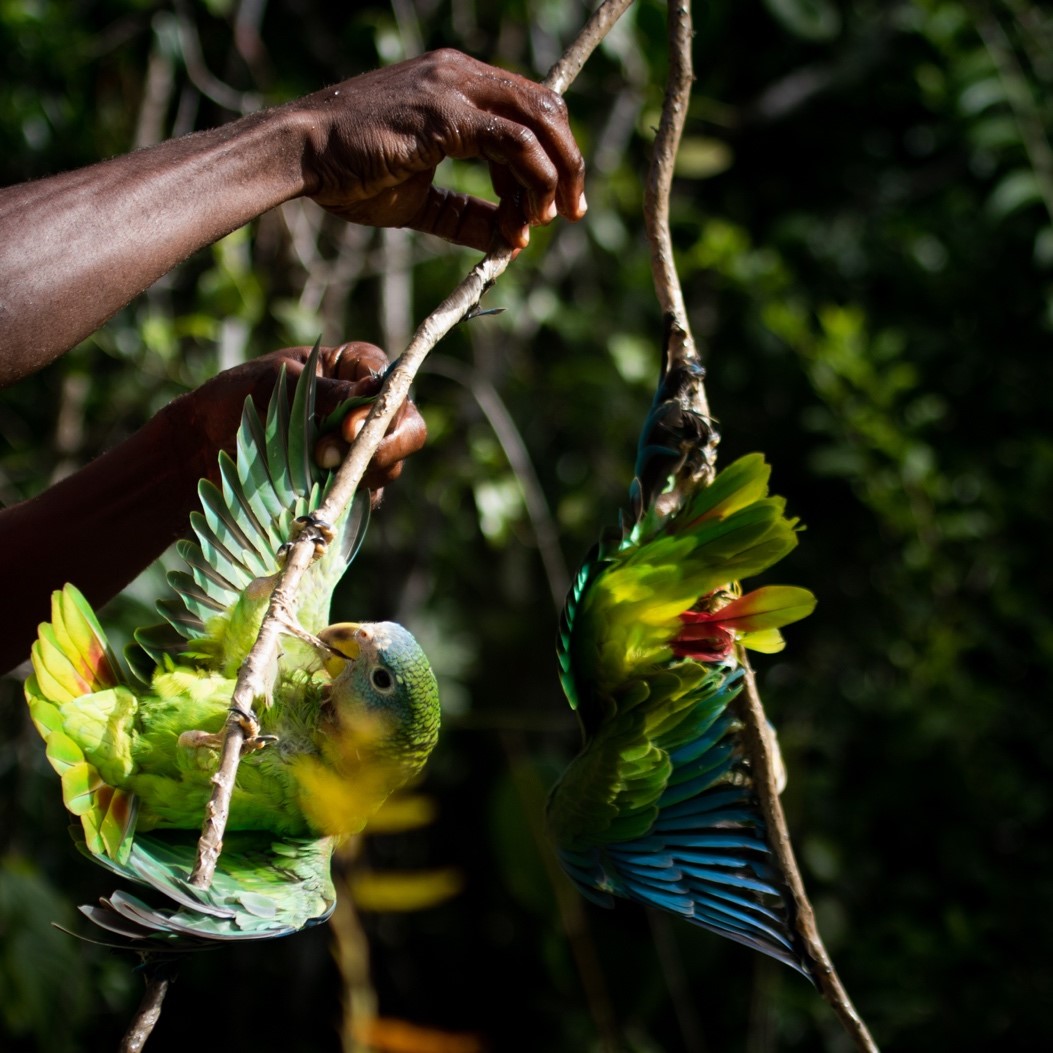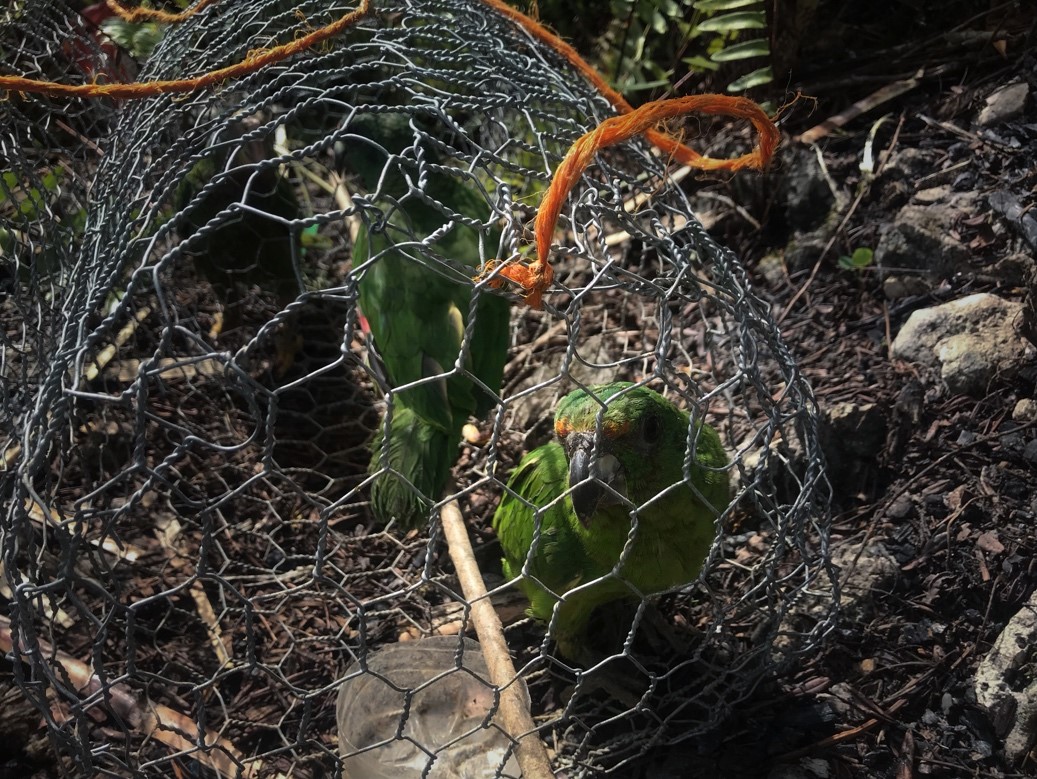Award Holder: Lydia Gibson
University: University College London
Title of Research: Saving Parrots, Destroying Traditions? The impact of conservation and its narratives on Maroon culture in Jamaica
We moved in mechanical silence through still and empty darkness like tin soldiers, long-forgotten by their puerile companions, wound no longer for joy but for maintenance. Each night I accompanied the remaining hunters, I became evermore cocooned into the bitter solace that the practice now was. It was the third hunting season I had observed. While I had become adept at many of the constitutive tasks – my once-soft mass transformed into a toned pillar of expertise – the hunt grew increasingly unfamiliar. My doctoral research had set about to explore traditional parrot hunting among indigenous Maroons in Cockpit Country: a tropical rainforest in the west-central uplands of Jamaica, designated to become a protected area. I had sought to assess the sustainability of parrot hunting, by analysing the off-take, and its importance to Maroon culture in order to advocate for its continuity and against the restriction of access and resource use that often accompanies protected area designation. It was for this I sought the Horniman fieldwork grant (among others – it was a rather expensive endeavour). Traditional parrot hunting is undertaken by fewer than ten men, for two months of the year (between July and August, when the fledglings emerge after the breeding season; apparently, they are the only ones asinine enough to fall for this contraption – so I am told by the hunters). The lessons offered to me from observing such an exclusive group undertaking such an indulgent and clandestine activity, within a community whose association to the term indigenous is shrouded in such apprehension, on a small island in an overlooked archipelago, present far-reaching consequences for conservation, its execution and impact, and the growing role of the anthropologist as witness, collaborator, co-narrator, co-conspirator.

Figure 1: Map of Cockpit Country Forest Reserve, with roads and nearby villages to show its remoteness
Cockpit Country is unmistakeably dense and characteristically hilly. So inaccessible is its terrain that for centuries it protected the Maroons (semi-autonomous communities formed through the merging of the first escaped Africans and remaining Taino population) from (re)capture by the British during the Transatlantic slave trade. This “green armour” also protects the many rare bird, amphibian, and bat species native to Jamaica, many of which can only be found in Cockpit Country. The same features that have made this space a refuge for biodiversity, the once-enslaved, rare forms of afro-Jamaican spirituality, and the rich heritage that constitute a large and significant aspect of Jamaican colonial history has also centred it within the crosshairs of conservation’s gaze. But such inaccessibility has heavily impacted the emergence of forest conservation in Jamaica. Large swathes of the forest remain uncharted; satellite imagery is made redundant by the heavy blanket of canopy cover. The dense, uneven, unnavigable terrain also renders useless other technologies upon which modern conservation relies. There is little flight path available for drones, there is no internet available for remote uploads, GPS trackers are difficult to install because nests and breeding grounds are largely unknown and often abandoned between – even during – breeding seasons, and camera traps yield little because the species are small and/or poorly detectable. It is this backdrop – of inaccessibility, frustration, technological absence, and what I have just now decided to call “institutionlessness” – that my engagement with traditional ecological knowledge, conservation, and forest use finds itself vanward of.
Fieldwork took place over two years in three 3-month periods: an initial pilot in the summer of 2017 and two subsequent “parrot-focused” field trips in 2018 and 2019. There was to be another in 2020 – Covid-19 saw to that. Fieldwork will resume in and continue beyond 2021, as part of postdoctoral research. Sitting at the intersection of natural and social sciences – anthropology and ecology in particular, my research incorporated a broad range of methodologies. Alongside participant observation of village life, where I lived and worked each summer with my two young children, I attended over 30 hunts (including 14 in 2018 and 15 in 2019). During hunt attendance, I collected catch statistics (time and date of catch, species caught, flock size, weight and sex of parrot) and deployed data loggers ¬– devices that automatically log readings of ambient air temperature and humidity at predetermined intervals – and rain gauges. The diversity of methodological approaches and technical actions provided a number of disciplinary axes along which I was able to situate and (necessarily) mobilise analyses. They also, as it turns out, provided analytic and conceptual obscurity that shielded my ethnographic work. The hunters were well aware of my furiously-scribbled fieldnotes and knew I was listening – I made sure of that, returning to conversations during which I initially appeared otherwise occupied. Yet had I not engaged with the busy work of ecology – setting camera traps, deploying loggers, and performing a technical expertise that legitimised my interest in the hunt as a biological rather than a cultural inquiry – I doubt their guard might have slipped so far beneath their typically sceptical reach. This is something we will have to grapple with as anthropology continues to unfurl itself across natural sciences with growing interdisciplinary applications. A dilemma all the more concerning given the ethical complacency with which the discipline and its practitioners often operate despite the well-known murkiness of its colonial history.

Figure 2: Data logger deployed in hunting grounds
Parrot hunting is a tapestry of luck, skill, and social obligation. It begins weeks before the hunting season, with the manufacture of the adhesive – “tar” – onto which the parrots become stuck when they are trapped. It is made from the sap of the breadfruit tree. The village is peppered with them, yet the hunters travel hours by car to another part of the island to tap breadfruit trees. The hunters say the trees in the village have been emptied of their sap long ago. The sap is boiled for many hours and oils are added. There is an art to making tar; some hunters make stronger, more-pliable, adhesive that lasts the season without rotting – others do not. The other thing hunters must do before the season starts is secure a caller: caged parrots hung undercanopy, out of sight, acting as live lures to trap the wild parrots. Hunters save at least one parrot from last season’s catch for this very purpose. Once the season is underway, the caller is immediately replaced.
The hunting grounds are almost two hour’s walk from the village; arrival must be well in advance of the birds’ crepuscular activity in order to set up without scaring away potential catch. Consequently, the journey takes place in the blue-black dark that precedes dawn. Once at the grounds, nestled atop a particularly steep summit from which even the fittest and youngest must first recover, a number of tasks await. Firewood must be collected and the fire, made. More wood must be gathered for the fire-pans – old cooking pots repurposed into portable mosquito smokers. The tar – solid at rest – must be heated and wound onto whittled perches. Necessary repairs must be made to the tree. The trap must be erected by affixing the perch to a high branch so it pierces the canopy without snagging leaves. Parrots will not perch if the surface does not remain smooth and clean. The perch should not lean and should face the optimal direction – which direction this is, I still do not know, but the more-experienced hunters seem to know precisely where that is for each trap. It is hard to see if it is done properly from underneath one’s own tree; the hunter must be guided by the others. Callers must be unsheathed and then hung. This must be saved until last. The callers must remain covered during the journey, so they stay silent during site preparations. As parrots are caught, they are slung in plastic bags to be processed and distributed at the end of the hunt.

Figure 3: Yellow-billed parrots caught on adhesive trap
Indigenous and traditional knowledge is often portrayed as a humble, collectively-maintained public good. Parrot hunting, and the wealth of ecological knowledge associated with its practice, is a pursuit for the well-off and the well-connected. There are significant costs involved: raw materials required for husbandry (wood, metres of wire mesh, land to build a coop); a parrot in-hand as a live lure; cages, feedbags and plastic bags, all used for storage and transportation; sturdy boots; a machete. A seemingly-informal but deeply-complex patronage system allows hunters to borrow these items from other hunters. The sharing ritual – that governs how catch is allocated – takes into account items that were lent. Older hunters with more resources but waning skill are ensured some of the season’s catch; younger hunters without the means are able to participate. It is males from wealthier, larger, or well-connected households that are afforded the time and the means to engage in traditional practices. Women and those from smaller/poorer households reliant on wage labour are less able to access cultural activities – either parrot hunting or the few others that remain (guano collection for fertiliser; foraging for medicinal seeds, wild tubers, fruits). The decline of cultural practices is often reported as younger generations turning their backs upon a tradition as it lays helpless, dying on the earthen floor. The reality is that these practices are highly exclusive and selective. That it lies precariously on the brink of extinction is, for some, a very lucrative position indeed. Many do not reject cultural practices; they simply cannot access it.
There are two species of parrots endemic to Jamaica – the black-billed and the yellow-billed parrot. The latter receives more conservation attention as its larger body size and more colourful plumage (i.e., greater attractiveness) places it under more significant hunting pressure. This pattern is true for all parrots – particularly in the neotropics. Yet during the hunts it became clear that the population of black-billed parrots was either in decline or undergoing extreme fluctuations. By the end of the 2019 hunting season, black-billed parrots comprised less than 5% of the catch yield; most of those caught were hybridised with a non-native congener; and all appeared so late in and after the season that it was clear the breeding season had shifted considerably. This is the kind of indigenous knowledge over which conservation salivates, particularly in inaccessible regions plagued by “institutionlessness”. These findings, despite lacking the systematic, quantitative basis preferred by assessment teams, led to the black-billed parrot being upgraded to Endangered. There is no scope in this summary to fully discuss the implications of this outcome for the hunters. I will say that my initial fear and apprehension about the extent to which this could impair/undermine hunting practices and restrict forest use because of the increased conservation scrutiny that is likely to accompany this uplisting is complicated by my growing understanding of the cultural entrepreneurship and demagoguery implicated in traditional knowledge. Indigenous knowledge is becoming increasingly incorporated into mainstream conservation. This is partly because there is a growing consensus over the interdependence between biological and cultural diversity. It is also, as my research both further uncovered and reproduced, because these collaborations justify and legitimise practices of exclusivity and exclusion.

Figure 4: Two of the few black-billed parrots caught in 2019; the forehead colour indicates it has hybridised with a non-native species
As I moved between spaces of expertise, each discursively branded with specific forms of technical action (which were in fact forms of capital) – the hunters and their cultural capital, the conservation NGOs and actors and their scientific capital, the state departments and their political capital – I began to see how knowledge was leveraged to produce a very specific form of power. Specialist knowledge no longer held just functional importance; it became a symbolic representation of credibility and legitimacy as a stakeholder. As conservation stakeholders sought common ground, scientists, advocates, and indigenous knowledge-holders reproduced these fiefdoms of expertise through distinction from non-specialist groups. Scientists determining the extinction risk of species have diverged into technically-, taxonomically-, and morally-defined sects. Traditional practitioners began to deploy strategies of exclusion – concealing navigation routes, changing meeting times, suppressing information around catch yields. NGOs took legal action against the state department for failing to divulge information.
‘The colours which approach the dark side, and consequently, blue in particular, can be made to approximate to black; in fact, a very perfect Prussian blue, or an indigo acted on by vitriolic acid appears almost as a black’
—Johann Wolfgang von Goethe, Theory of Colours (1810)
The final hunting season marked a period of loss. Younger hunters abandoned the hunts, older hunters became increasingly exclusive in response, there was unprecedented trap failure as the tar lost adhesion, parrots grew fewer and farther between, a national ban on single-use plastic bags meant extreme rationing of a once-abundant critical storage and transportation. Walking sullen and steadfast with the remaining hunters under the liquorice-dipped blue-black sky presented an opportunity to observe the dark side of “people-centred” conservation and the actors engaged in, and in many ways imprisoned by, it. Observation of the never-before documented practice of traditional parrot hunting – an activity (a) undertaken by the privileged males; (b) shrouded in secrecy, betrayal, and exploitation; (c) for the sole purpose of supplying the domestic pet trade – extends analytical scope past the impact that conservation has on forms of land and resource use seen as justifiable, worthy, necessary, or sustainable to forms that are undeniably exclusive, indulgent, and ignoble. It also provides a fresh, and timely, conceptual lens through which to interrogate the ethics of participation. Not the biases of western interlocutors or the ethnographic authority of the anthropologist. Rather the social, political, economic, and technical arrangements that constitute local engagement and the production of ecological knowledge – mired with and enmeshed in exclusivity, specialisation, and mechanisms to award and deny credibility. As the outstretched arms of conservation and climate action reaches further into these “wild”, institutionless spaces, yet to be fully corrupted by colonial regimes; as specialist knowledge balkanises communities, stakeholders, and entities into factions coalescing around particular articulations and instantiations of indigeneity, science, nature, morality; and as technical and cultural practices are reshaped and sharpened into more contemporary, more justifiable technologies of power, it is time to rethink and acknowledge the inherent violence in participation; looking beyond the blue, into the black.